I can’t say that we were now sated after the excuse for a lunch we’d had in the plaza at Lamud, in fact, it was a bit of a relief to be told we were running a trifle late and we should hurry up and get into the van for our next jaunt. Like with all tour groups, there’s that couple that always seems to disappear when it’s time to go, and ours was no exception, twenty minutes of hunting for these two, for the third or fourth time, and they finally showed up – having wandered off to explore the town a little, no apologies, no nothing, in fact, I’m not sure the two of them ever said a word the entire three days, at least to anyone else.
Divested of our boots and rain gear, the skies having cleared up, we headed out for another hour across some of the muddiest, most pothole filled roads I think I’ve ever been on. Our guide assured us not to worry, at the end of this we would pull into a small plaza in Karajia, and from there it would be a short, 10 minute walk to the little known but spectacular 800-year old funerary site of the Chachapoyas culture. Of course, that was not to be.
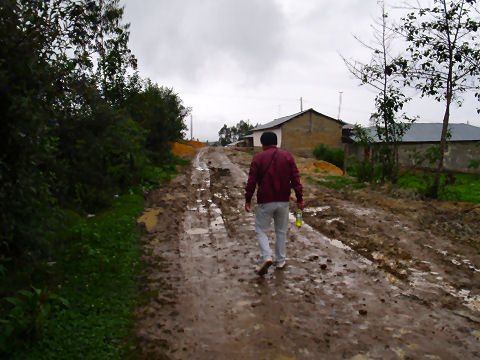
The heavens clouded up again, the rain started down if not in torrents or buckets, at least steadily, and in short order the van could go no further. It was time to walk. We didn’t have boots anymore. Town was only… a kilometer away.
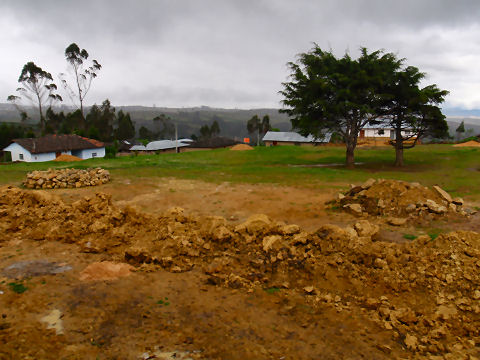
Town is, perhaps, a misnomer. This was a collection of houses, a few dozen at most, centered around what could only be called a plaza by the most charitable. It was a rectangle of mud and grass, unadorned, the perfect site for my hometown’s annual
Mud Bowl. We did, however, find a couple of locals in possession of various pairs of boots who were willing to rent them to us for the rest of the trek, a worthwhile investment of 5 soles apiece (about a dollar and a half, though likely half a day’s wages for them, per pair).
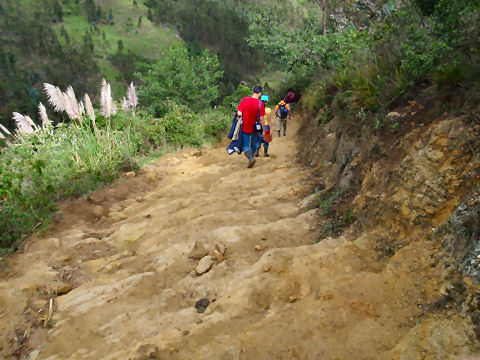
And then it was out the other side of the village and on down the side of a steep, slippery hill – no ten minutes here, it was close to an hour’s clamber, even in nice weather it would likely have been half an hour – it’s almost a kilometer and a half from town.
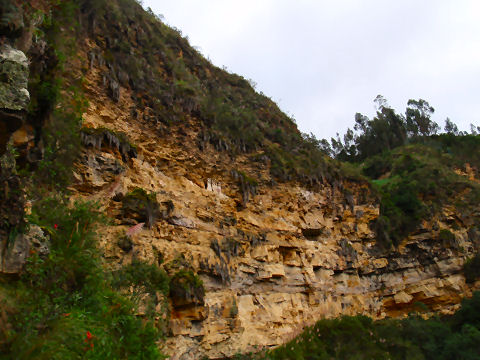
At one time, some 800 years ago, this was not a semi-circular sheer cliff, but a sloping terraced hill down to the Urcubamba river below, with, based on archaeological evidence, close to a thousand sarcophagi of various forms. The dozen, of different shapes and states of being, that remain, are what we came to see.
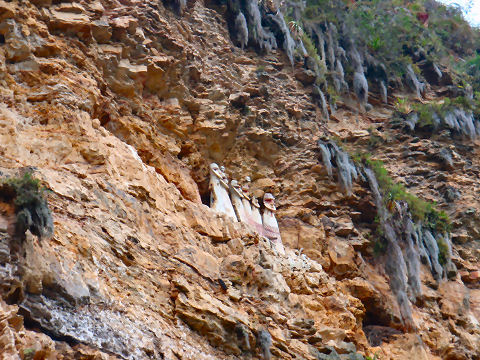
The “most important”, at least of those that remain, are these five that stand guard high on the cliff now. It is presumed that these were tribal elders, spiritual leaders, the guardians of the dead. Each contains the bones of one person. A couple are topped by a skull, supposed to represent the conquest of one particular rival or another, I wasn’t clear.
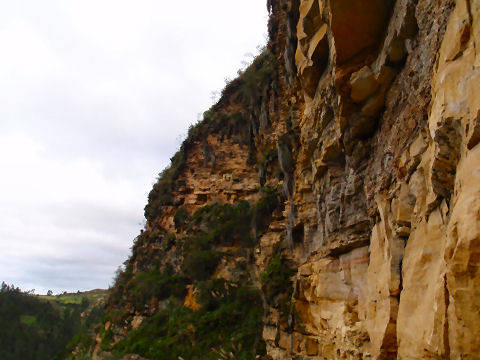
Crossing the narrow path that crawls below the cliff, we came to the other side and looked back – hard to make out, but more or less in the center of the far side, above where we’d entered the site, is another small grouping of sarcophagi, these in capsule form.
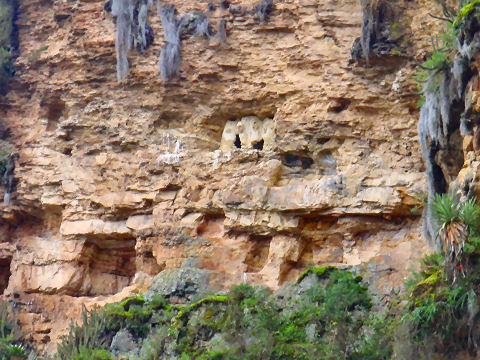
And a bit closer look at those. Here and there, in nooks and crannies, are bits of others, the ground far below is still littered with bones and shards of one or another sarcophagus. It is hard to believe that with the discovery of this site that none of it seems to be roped off for an archaeological dig, but it’s not.
We are not looking forward to slogging our way back up that hill, slippery as it is, but it is time to go, and we do, slowly making our way back to town where we leave behind the boots, retrieve our mud-caked shoes, thank our benefactors, and still have that kilometer walk through more mud back to the van, followed by a couple of hours winding our way back down and then up the wet and now more treacherous mountain slopes to Chachapoyas.
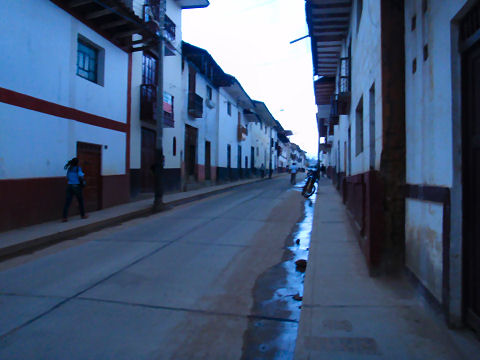
I’m not sure why I didn’t snap more pix of town, but so be it, this is a typical street in town. It had stopped raining by our return and dried out. After cleaning up we took a little wander around.
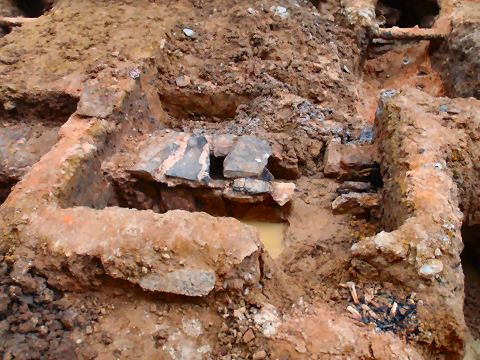
This, by the way, is what they uncovered in trying to install a new water main, a stone water supply that has, they estimate, been running under the streets, unused for a couple of centuries at this point, but was very possibly built some 3-400 years ago.
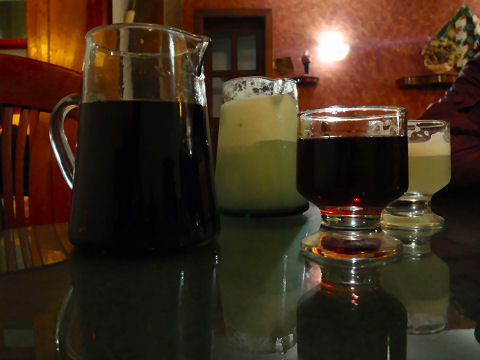
Our guides and several others recommend
La Tushpa, a couple of blocks off the main square, as one of the best spots in town to get authentic, local cuisine. Our Karajia guide in particular waxed poetic about the three different preparations of
cuy – fried, stewed, or roasted and topped with a nut sauce, the latter sounded amazing. We found our way there, it’s a cute little place, seating about 50, and attended to by the owner, a stout middle-aged woman. Alone. Well, almost, there’s an ancient guy there who hobbles about and carries things for her. Needless to say, service, though friendly as could be, was less than attentive, as the place was packed with locals and visitors. We eventually got drinks, and decided not to press our luck by sending back the half-liter pitchers of pisco sour and mora (fresh blackberry juice spiked with
aguardiente) that we received instead of single cocktails.
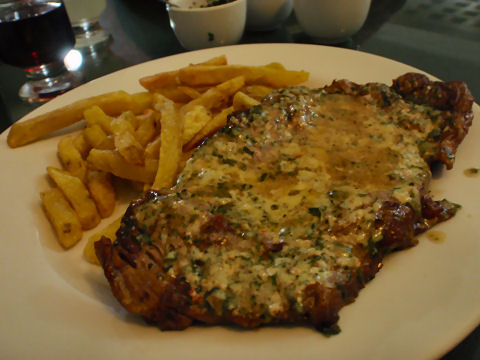
We were also to be disappointed in our keen appetite for the
cuy, as a) not only were they out of guinea pigs, apparently they sell out first thing in the evening as they raise them themselves at home and only bring in a few each day, but b) she had no idea what we were talking about in terms of the three preparations, they only offer fried, she could only assume our guide was thinking of somewhere else. Her recommendation, the
lomo finito al ajo, a thin steak, fairly tender and not at all fatty, thankfully, covered in garlic sauce. With fries. It was good, but nothing that interesting – Henry had another
lomo saltado and pronounced it not as good as the one the night before at
Chacha. And,
La Tushpa was definitely more expensive, if nicer ambiance.
Back to the hotel and some sleep before our final trek of the trip.















